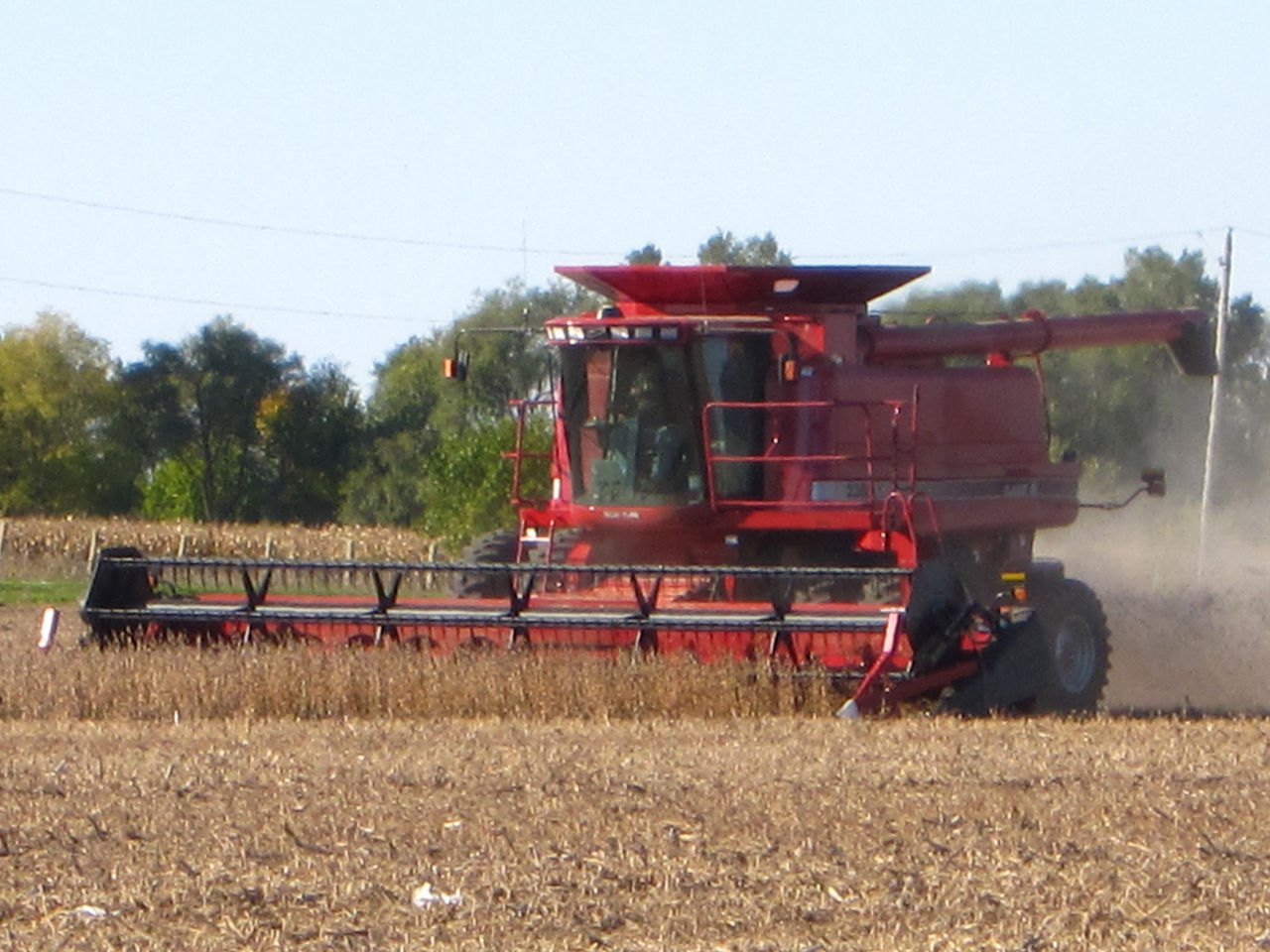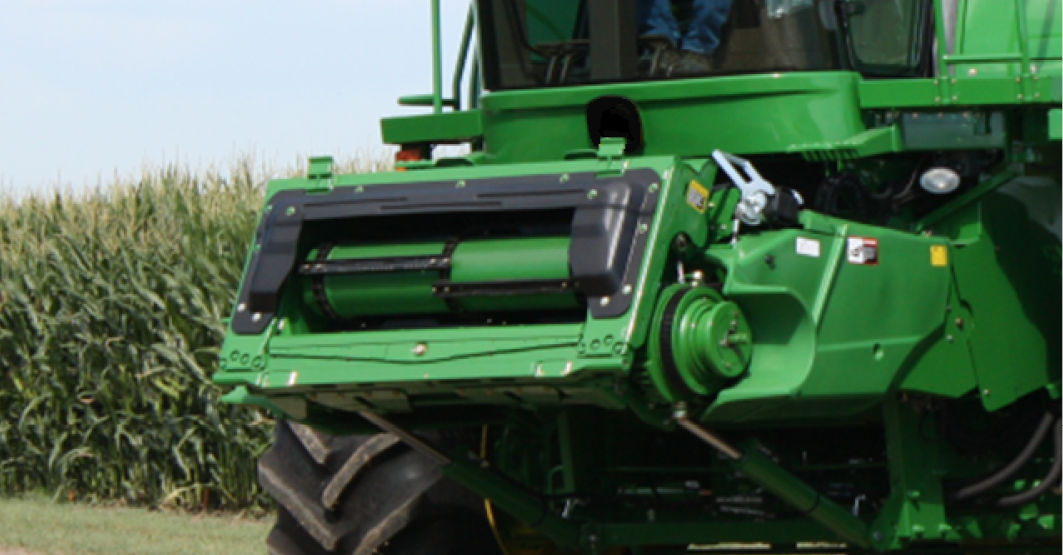3 MIN READ
Combine Adjustments and Maintenance for Harvest
July 17, 2025
Introduction
Combines are complex machines that gather, thresh, and clean the grain they are harvesting (Figure 1). To help minimize harvest losses and deliver high quality grain, combines need to be maintained, properly equipped, and adjusted for the crop to be harvested. The goal of proper adjustments is to achieve a smooth and even flow of crop material through the combine. The manufacturer’s manual is crucial for making recommended settings and adjustments.

Safety – BE AWARE, BE CAUTIOUS, SHUT IT DOWN
The manufacturer’s manual safety section should be reviewed to become aware of how to be safe when performing maintenance and operating the combine. With their many moving parts and overall size, combines can be dangerous to the operator and to anyone around the machines. Above all, the machine should be shut down when working around the header and other moving parts and the header blocked up before crawling under it. Holding a safety meeting with employees and family members should be included in pre-harvest activities to inform everyone of the potential hazards of an operating machine. Lacerations can easily occur from razor sharp auger flighting and metal edges; fingers can be pinched in chains, sprockets, shields, and other equipment; limbs can be crushed in headers; and flying residue from the rear of the machine can be painful at the very least. For road safety, make sure all lights are working and slow-moving vehicle emblems are cleaned to maintain visibility. Periodic cleaning of debris during harvest and keeping bearings properly greased can help reduce the potential for fire. Fire extinguishers should checked, and filled and be readily available in the cab and mounted on the combine.1,2,3
General Maintenance
Before harvest, follow the maintenance checklist provided by the manufacturer and inspect for any worn parts.1,2,3 Items to check include:
- Roller chains on a corn head or the knives on a cutterbar.
- In the threshing and separation area, the rotor and concave should be checked for wear or damage.
- In the cleaning shoe area, the sieves should be examined.
- Augers should be examined for sharp edges, as they can lead to grain damage or be a personal health hazard when accessed.
- Bearings should be checked for tightness and ability to properly grease.
- The engine should be serviced, and any debris removed around the engine and exhaust system to help reduce fire potential.
- Chaff and other residue should be removed throughout the combine to reduce the potential for fire.
- Monitors should be operated and examined for proper function.
Header Adjustments
The header is the first contact point with the crop and can be the largest source of grain loss. On a corn header, gathering chains pull stalks back into the header, stripping rolls pull the stalks down, and deck plates pop ears off the stalks. If the gathering speed is too slow, corn stalks entering the header can be pushed forward and ear loss can occur. If the gathering speed is too fast, ears can be damaged with kernel loss as they impact deck plates. Speed settings are correctly matched when stalks are pulled straight down after entering the header and ears are gently snapped off without damage. Stripping roll spacing should be set according to stalk thickness. Deck plates should be set as wide as possible without losing ears or shelling corn off the ear. The ears are moved by a cross auger to the center of the head where they enter the feederhouse, which is a series of individual wide bars that move the ears into the threshing unit (Figure 2). The cross auger clearance from its housing must be adjusted for ear size to work efficiently. The corn head gathering speed and feederhouse speed should be matched to the combine drive speed to effectively move the ears into the feederhouse and threshing system without causing plugging or grain damage. As crop and field conditions change while harvesting, appropriate adjustments should be made.2,3
Cutterbar knife sections should be checked for breakage, sharpness, and closeness to the guard shearing surfaces. The reel axis should be adjusted to be about eight to 12 inches ahead of the cutterbar with the fingers coming no closer than two inches from the cutterbar in its raised position.1

Feederhouse Adjustments
Feederhouse adjustments and settings need to be made according to the crop. It is important to set the proper height position of the feed drum to prevent grain damage. The feed accelerator should also be set at low speed so that whole ears are moved into the combine to start the threshing process. If the accelerator speed is set too fast, corn cobs can break apart and kernels can be lost before the threshing process begins.2,3
Threshing Adjustments
Adjustments to threshing and separating parts of the combine are important for an efficient harvest. Threshing requires a balance between rotor speed and concave clearance. The cylinder or rotor speed is the leading cause of grain damage by the combine. Use the lowest possible rotor speed that efficiently shells the grain. When setting the rotor speed and concave clearance, begin with factory recommended settings as a starting point and fine-tune for the crop and field conditions. A properly adjusted rotor speed and concave clearance detaches most of the grain from the cob. If the rotor speed is too fast, corn ears can break apart and kernel damage can occur resulting in cracked grains and fines entering the grain tank. If the concave clearance is too wide, complete threshing doesn’t occur, which can result in split cobs showing up in the tank. For good threshing and separation, guidelines to follow include:
- The rotor chamber should be kept full to minimize grain damage.
- Rotor speeds should be set as low as possible for proper threshing to occur.
- The concave spacing should be closed to increase threshing capability.
- Rotor speed should only be increased as a last resort.
Grain Cleaning Adjustments
After threshing, the grain is separated from the non-grain crop material by the chaffer and shoe sieves and the cleaning fan. The chaffer is the upper sieve that allows all grain and un-threshed cobs or pods through to the shoe sieves which allow only grain to pass. Un-threshed crop portions go into tailings and return to the rotor cage for re-threshing. Sieve and fan settings are critical to deliver clean, high-quality grain and should be set to specifications. If the fan speed is too low, pieces of stalks, stems, cobs, pods, and other material can flow into the grain tank. If the fan speed is too high, you can lose grain out the back of the combine. Sieve adjustments should work in tandem with fan speed for best results.
Calibrating Yield Monitor
Yield monitors should be checked for proper operation and calibration. The manufacturer’s manual should be reviewed for any needed adjustments. Please also see Combine Calibration and Yield Mapping Best Practices for Wheat for additional yield monitor information. The article refers to wheat; however, the information can be applied to other crops.
Summary
Computerization of modern combines has replaced many of the physical wrench-on-the-bolt adjustments. Adjustments are just a fingertip away and can be made quickly as field and crop conditions change. Generally, it is recommended to only make one adjustment at a time before making another and making them in small increments. Time should be taken to observe the ground behind the combine for any lost grain and determine if the loss is acceptable or adjustments or repairs are necessary to reduce the loss. Two corn kernels or four soybean seeds per square foot on the ground is equivalent to a one bushel per acre yield loss. Additionally, a 0.75 lb ear on the ground per 1/100th acre equals a one bushel per acre yield loss.1 Observation of the grain in the tank can help determine if settings need to be changed to remove foreign material.
Sources
1Hanna, M. 2016. Combine adjustment for fall harvest. Integrated Crop Management. Iowa State University Extension and Outreach. https://crops.extension.iastate.edu/cropnews/2016/09/combine-adjustment-fall-harvest
2Humburg, D. 2016. Chapter 37: Combine adjustments to reduce harvest losses. In D.E. Clay, C.G. Carlson, S.A. Clay, and E. Byamukama (Eds.) iGrow corn: Best management practices. South Dakota State University. https://extension.sdstate.edu/sites/default/files/2019-09/S-0003-37-Corn.pdf
32018. Combine adjustments. Corn Agronomy. University of Wisconsin. https://corn.aae.wisc.edu/Management/L036.aspx
Web sources verified 6/25/25. 1012_71501